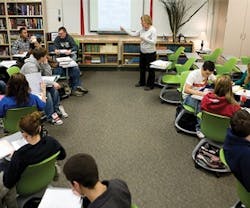As students, teaching styles, and the education system progress, so must its furniture. Gone are the days of the inflexible, stationary wooden desk/chair combo. Like the students, school furniture of the future is flexible and mobile.
"The trend we’re seeing now is that schools are thinking of the classroom less as a commodity and more as an environment to invest in – like a thoughtful learning environment that improves the learning experience," explains Elise Valoe, senior design researcher for Steelcase.
Collaboration Compliant
Office and classroom alike are finding value in flexible and collaborative spaces – both of which require furniture conducive to these relatively new schools of thought. Instead of giving individual assignments, teachers are finding value in assigning group work.
"We’ve seen through our research that there’s been a move in different teaching styles and pedagogies, and teachers are implementing more of a constructivist pedagogy (a more student-centered style in which teachers guide, rather than instruct), so they’re introducing more collaborative, active activities in the rooms," Valoe says. "Because teachers are driving this and students are asking for more engagement in the classroom, schools are building classrooms to meet these needs. Because of this paradigm shift, furniture needs to support collaboration."
Supporting collaboration (and unconventional classroom teaching techniques) requires furniture to easily transform from a straight-rowed classroom setting into cluster environments.
"I’m seeing a lot of movement towards flexible, mobile furniture – furniture that is easily reconfigured," says Margaret Sullivan, library marketing and sales manager for Smith System, Inc. "What I see in classrooms is a lot of decentralization. There isn’t a front of a classroom anymore. Depending on how teachers want to reconfigure the kids to work together, or what kind of projects they’re working on, they have to have furniture that will move and be flexible."
Lightweight systems allow students to move desks into cluster formations for group work and then back into rows for lecture or individual work. Swivel seating allows students to adjust their seating positions – and focus. Larger work surfaces on desks allows the use of multiple mediums – from paper notebooks to electronic notebooks.
Readily Reconfigurable
Reconfiguration is also important for the teachers and janitorial staff. "No matter what happens in the classroom during the day, is the furniture easy enough to reconfigure to clean the room and to put it back into shape?" explains Sullivan. "Do you have furniture that’s ergonomically flexible enough that anybody can handle it and manage it without being injured or having problems?"
Administrators are also seeing the need to have mobility built into the furniture. "I’m seeing wheels on just about everything," she says. "I talked with a school administrator the other day who said he wanted to be able for his maintenance and custodial people to go in every summer and redo floors and he didn’t want furniture that is impossible to move."
Ergonomic Advantage
Not only is school furniture becoming more adaptable in terms of reconfiguring in a space, it is literally becoming more flexible – components are being made of more bendable materials. This added flexibility allows for ergonomic support.
"I did a focus group with teenagers a few years ago," says Sullivan. "Their No. 1 complaint was how uncomfortable furniture was in schools. I think you’re going to hear more and more about the ergonomic component and how they don’t want to be in an uncomfortable environment for six, seven, eight hours a day. The materials are becoming more available to create comfortable furniture that is lighter, yet holds up well and is durable."
School furniture is trending to be more student-centric. Unconventional teaching techniques, collaborative projects, and ergonomic concerns all require different levels of furniture flexibility. "You focus on what the students need to be successful," says Sullivan, "and the furniture complements that."
Kylie Wroblaski ([email protected]) is associate editor of BUILDINGS.
